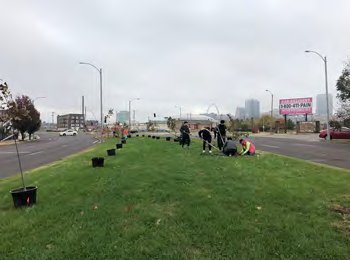AgEBB-MU CAFNR Extension
Green Horizons
Volume 25, Number 3
Fall 2021
Tree Equity: Fancy Concept or For Real?
Rebecca Hankins, Partnership Coordinator at Forest ReLeaf
Among the headlines that dominate the environmental conversation these days, a new one is emerging called Tree Equity. It may seem like some newly-contrived concept to sound important and relevant, yet it engulfed the front cover of National Geographic's July issue with a simple headline entitled "Beating the Heat". Simultaneously, National Geographic's podcast Overheard continued the conversation in an episode titled "Cooling Cities By Throwing Shade", which debuted on August 3. Articles from major cities around the nation are cropping up talking about Tree Equity. So what is it?
 |
| Screenshot of St. Louis City Photo Credit: Tree Equity Score Tool by American Forests |
Tree Equity specifically focuses on the urban tree canopy (trees in our cities versus our forests). On the surface it is a conversation about where trees are in cities and why. More deeply, it is a compilation of layers of data that essentially point to one thing: urban trees are not equally distributed. American Forests, the nation's oldest national conservation organization, is the originator of this new buzz word with the launch of their nationwide Tree Equity Scores on June 22, 2021.
Tree Equity Scores combine existing tree cover stats with other data such as population density, poverty and unemployment rates. More information can be found at www.americanforests.org. This data determines whether there are enough trees in a location to provide optimal human health, as well as climate benefits. According to Jad Daley's press release statement, president and chief executive officer of American Forests, "It shows us exactly where the problems exist, where we need to concentrate investment to solve them, and where we need to bring people together - all different types of people and organizations." That doesn't sound like a concept at all, but a real solution to green infrastructure problems that are plaguing urban centers.
Forest ReLeaf of Missouri, the state-wide nonprofit tree nursery located in Creve Coeur, Missouri, is excited that Tree Equity is being talked about and taken seriously. For years, Forest ReLeaf has known that Missouri's urban tree canopies are not equally distributed and implemented a Priority ReLeaf program for those areas defined by low tree canopy. Now, with this new Tree Equity Score tool and local tree inventories, Forest ReLeaf can make further impact in these neighborhoods by using data to engage the communities and garner greater support from partners.
 |
| 2017 Priority ReLeaf tree planting in Old North St. Louis Photo Credit: Forest ReLeaf |
Every person deserves to experience trees. As we have seen through the Covid-19 pandemic, access to green spaces can make a huge difference to how people handle stress. If you are fortunate enough to live in a highly forested area, you may not even notice the soothing embrace trees wrap around you. Visit a highly urbanized city, where impervious surfaces and buildings abound, and you quickly notice the lack of green canopy. Tree Equity Scores begin to address this problem with the goal to help everyone, no matter who they are, receive the many benefits that trees provide.
As always, Forest ReLeaf is here to provide anyone in Missouri access to free trees who have a planting project on public land. Our Project CommuniTree is now accepting applications for Fall. To apply, visit moreleaf.org/plant/project-communitree/.
To learn more about Tree Equity check out https://www.treeequityscore.org/ Be sure to click on their interactive map to find your hometown.
